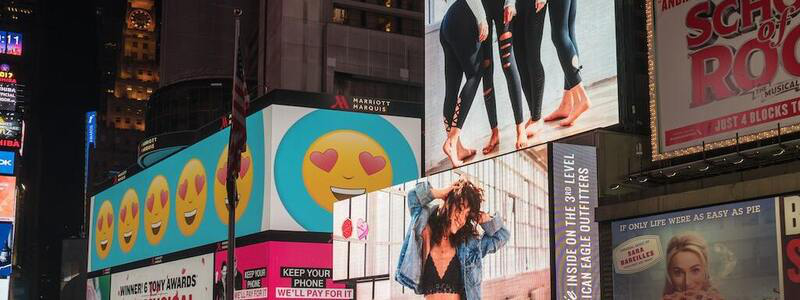Traditional Billboards vs. Digital Billboards is an article that looks at two effective forms of advertising. While conventional billboards have been around for decades, digital billboards are a relatively new addition to advertising. This article aims to compare the two and help businesses determine which option is best for their needs. Both advertising forms have advantages and disadvantages, and companies need to weigh these factors before making a decision.
Traditional billboards are often seen as more affordable. Still, digital billboards offer greater flexibility and the ability to target specific audiences. On the other hand, traditional billboards provide more stability and reliability, while digital billboards can be subject to technical issues. This article will provide an in-depth look at Traditional Billboards vs. Digital Billboards and help businesses make informed decisions. Want to get your message noticed? Look no further than Out-of-Home advertising.
Out-of-home advertising is a powerful way to reach consumers on the go. Whether traditional or digital, billboards are powerful means of reaching potential customers.
With over 350,000 billboards across the US market, this tried and tested form of marketing dates back to ancient civilizations carving their messages into stones.
Choosing which route to take can be difficult for small business owners.
Both options have their unique benefits that could work wonders for your specific situation
Are you thinking of boosting your media strategy with the addition of billboards? We’ll help break down the differences between traditional and digital billboards.
Looking at some strengths and weaknesses between the billboards, we will help you determine which strategy will lead your business to greater success.

What Are Traditional Billboards?
From the days of stagecoaches to modern road trips, billboards are a common sight across America’s roadsides.
These billboards are known for their broad reach and semi-permanent placement on highways and intersections. When you rent or purchase an outdoor sign, your ad will usually stay up for a while.
Billboards have been a tried-and-true way of promoting products to millions across the country for decades. Traditional billboards are always persistent in their mission to deliver distinctive messages that stay etched into public memory at every turn.
What Are Digital Billboards?
Blazingly bright and stunning, digital technology is revolutionizing the billboard experience.
These electronic billboards can be found along highways and landmarks in cities like Las Vegas, Times Square, or Tokyo.
Digital billboards are an ideal way for brands to engage with potential customers. Easily managed with their digital network connections, they have the ability to rotate advertisements on a schedule.
They are used within indoor locations such as kiosks, airports, mall walkways, or arenas.
Using LEDs and computerized controllers, these digital ads give businesses an eye-catching way to promote their products.
The Billboard Best For Your Business
Items To Consider:
Location Of Your Billboard
- For a successful billboard campaign, ads should be placed in high-traffic areas to maximize reach.
- Digital billboards are ideal for campaigns aiming to build brand awareness among a mass market due to their placement around towns and cities with the highest levels of footfall.
- When targeting specific impressions, traditional billboards in specific locations may be more effective.
The Reach To Your Audience
- Billboard advertising is a cost-effective way for SMEs to increase brand awareness in their local area.
- Digital billboards are eye-catching, but can be shared with up to five other brands at any given time.
- Traditional billboards offer exclusive exposure and maximum visibility within the targeted location.
Cost Of Maintaining Your Billboard
- Traditional billboards can range from $250-$550/month in rural areas to $1,500 – $4,000/month in small to mid-size cities.
- Digital billboard prices start at around $3000/month and can go up to as much as $10,000/month in major metropolitan areas.
- Traditional billboards are more cost effective over a longer period of time but have limits when it comes to testing ads since changes cannot be made easily.
- On the other hand digital billboard ads allow for quick and easy changes which might bring an acceptable ROI if chosen correctly.

Are Traditional Billboards For You?
The Pros:
- Companies can benefit from the exclusive use of ad space, allowing for 24/7 exposure and long-term brand recognition.
- Billboards are typically located in high-traffic areas with a 14×48 foot format designed to attract attention through extensions, cutouts and vibrant colors.
- Compared to traditional media such as radio, magazines or direct mail, billboards have higher prospective impressions (3X radio; 6X magazines; 10X direct mail).
- Older travelers are more likely to pay attention due to their familiarity with billboard ads which allows for word-of-mouth marketing over weeks or months.
The Cons:
- Businesses must consider production fees when updating or changing ads on traditional billboards, as the materials can peel, fade, weather and get dirty over time.
- There is a wait time associated with changing messages or ads due to limited space and unusual dimensions which limit information and call to action.
- Businesses should also be aware of potential accidents or vandalism that could occur if not properly maintained.

Are Digital Billboards Best For You?
The Pros:
- Digital billboards offer a cost-effective way to reach out to potential customers with eye-catching visuals such as moving effects, vivid colors and videos.
- With short display periods for reducing ad fatigue, customized schedules can target different audiences throughout the day or week.
- Digital billboards are ideal for short-term promotions or ads and can be triggered by weather conditions, news alerts or traffic patterns.
- Some digital boards even push social media posts while offering traditional outdoor advertising flexibility with greater impact due to LED display technology providing crystal clear images in prime locations that are easy to rotate messages on.
- This format ensures that the observer will not have the chance to turn away from the advertisement.
- Digital billboards are also unlikely to get damaged if they are placed at higher points.
The Cons:
- Digital billboards are generally more expensive than traditional ones, with daily costs ranging from $25 -$70 for the latter and several thousand dollars monthly for the latest digital technology.
- Most ads remain visible for only eight to ten seconds, and exposure time is shared among other advertisers in a 64-second loop.
- High demand may limit or delay availability of ad space on digital billboards.
Traditional Billboards vs. Digital Billboards – bMedia
When it comes to outdoor advertising, you have some things to consider. Do digital billboards with their targeted reach and flexibility fit the bill? Or can a traditional billboard get your message across within budget constraints?
Important factors will most likely guide your decision toward traditional or digital billboards. However, you don’t have to take this journey alone.
As a leading, trusted media company in the area, we at bMedia strive to be number one in delivering advertising that connects with your audience and helps you stand out. Our hallmark is ensuring maximum impact through quality excellence, fresh ideas, and superior services.










 787 792 4113
787 792 4113
